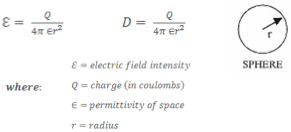Static dissipation arrays: a buyer’s guide Static dissipation array is a generic description of a system using point discharge phenomenon to protect a given object or area from a lightning strike. Static dissipation arrays are available in a variety of forms and have received various marketing pelations from their manufacturers. They have been around in various forms for many years, and their most thorough early description was by J.M. Cage in his patent issued in 1930.
If you are in the market for a static dissipation array, or in the process of evaluating or specifying one for a client, it can be very confusing: akin to comparing apples to oranges because of the diversity within the promotional material and operational claims of the various manufacturers. Exactly how (and if) they provide lightning protection is a subject of disagreement, but there are several parameters which can be used to form an objective and realistic basis of comparison. Several elements key to successful system performance are:
- Radius of dissipator electrode cross section
- dissipator construction material
- density of dissipator electrodes
- configuration of dissipator on structure to be protected.
Electrode radius
Static dissipation arrays work, as the name implies, by dissipating static charge. The radius of the dissipator electrode cross-sect ion is critical because the process which enables dissipation of static ground charge to the atmosphere is related to electric field intensity (and flux density) surrounding the dissipator. Static dissipation arrays provide, in effect, a “low resistance” route for static ground charge to reach the atmosphere, thus preventing a build up of the ground charge to the value necessary to trigger a strike.
Point discharge theory holds that electrical discharge from the point of an electrode to a surrounding medium will follow predictable rules of behavior. That discharge creates an electric field around the electrode. The theory, as it applies to this discussion, can be described by these basic formulae:
Since the above formulae tell us that electric field intensity will increase as electrode radius decreases, it makes sense to use the smallest radius electrodes possible consistent with structural integrity.
The critical qualities of the material used in static dissipation arrays are conductivity and durability.
In fact, by not using the smallest possible electrode cross-section, one would entirely miss the point of point discharge. For instance, a dissipator electrode of .015 inch is not merely three times less efficient as a dissipator electrode of .005 inch. As the above formulae indicate, the radius is squared, hence the factor is not three, but nine.
The critical qualities of the material used in static dissipation arrays are conductivity and durability The static dissipation array must be a good conductor to provide maximum discharge of current during normal operation, and, in the unlikely event of a direct lightning strike to the dissipator, a path for current flow in its role as a lightning rod. At the same time, the dissipator must provide a long and trouble-free service life, combining light weight and low wind resistance with durability.
Number of dissipator electrodes
Calculating the required number of dissipator points is not an exact science. One must not only dissipate the structure to be protected; one must also dissipate the ground charge, a function of the point on earth upon which the structure rests. Therefore dissipation requirements are determined not only by the structure, but also by that ground charge, i.e. the absolute difference in potential which must be reduced through dissipation and the rate at which that dissipation must occur to prevent a strike.
The ground charge is a function of the strength and speed of the storm. (It is possible that an elevated structure creates somewhat of a “venturi” effect, drawing more ground charge than that which would normally occupy the point on earth upon which it rests. However, to my knowledge no one has been able to confirm or measure such an effect.)
Since a static dissipation array must provide a low resistance path to the atmosphere, it seems logical to provide as many discharge points as reasonably possible. By using a large number of points one can compensate for any loss of efficiency from a theoretical maximum, and spread the dissipator elements over more of the cross-section area of the structure.
Density of dissipator electrodes
However, one cannot emulate the patient who, upon being told that three pills was good for him, decided that 30 pills must be better. Concerning the number of dissipator electrodes, there is a point at which more is less.
The density of the dissipator electrodes is critical because of the possibility of inter-point interference. If the dissipator electrodes are held too close to one another, the points interfere with one another’s ability to dissipate. Experimentation indicates that the smaller the radius of the dissipator electrodes, the closer they can be arranged without interference.
Given moderately close spacing, this interference only affects the dissipation capability of any given point: not of the system as a whole. Moderately close spacing of extremely small radius electrodes may lead to some inter-point interference and limited loss of efficiency by individual points. However, it is more than offset by providing a greater overall number of points and greater overall dissipating capacity.
At the extremes, too close spacing results in the array under heavy discharge approaching a solid surface, be it a cylinder, plane or toroid. On the other hand, if the dissipator points are too widely spaced, the result is unnecessary supporting structure with resulting excess weight, wind loading and cost. If dissipator points cease to interfere at a given distance, there is nothing to be gained by increasing that distance.
Assume, for a moment, that there is no problem of interference between dissipator points located in close proximity to one another. Another limiting factor arises; the ability of the volume of atmosphere surrounding the dissipator points to accept the charge. Therefore, the points must not only be separated to prevent interference, but also be separated to provide a sufficient volume of surrounding atmosphere to avoid “saturating” that surrounding volume of atmosphere with charge,
Of course, this does not take into account the effect of wind, usually present in abundance during the conditions under which peak dissipator discharge occurs. Wind presents constantly renewing surrounding volumes of atmosphere, and, if the dissipator electrodes are sufficiently flexible, continuous movement of the points in relation to one another providing momentar increases in spacing.
Configuration of dissipator on structure
All objects have natural dissipation points. On a structure, charge tends to gather at, and dissipate from, the top of the structure (the ultimate point) and from corners. The most effective way to mount a dissipator in terms of structure, weight, wind loading, cost and aesthetics is to enhance this natural dissipation by supporting the dissipator from the structure itself at these natural dissipation points, and to take advantage of any existing grounding and bonding provisions, particularly if the structure is a building. In other words, the dissipator should be tailored to the structure, not vice versa.
It was once believed critical to effectiveness that a dissipator be the absolute highest point on a structure. Practical experience has proven it need not be. Indeed, mounting a dissipator too high above the structure in an effort to clear all appurtenances can reduce the level of protection by allowing charge to continue to accumulate at the structure’s natural dissipation points. In certain applications such as electrically floating AM broadcast towers, it is inadvisable to install anything, including a static dissipator, above the top of the tower since it necessitates costly and time-consuming re-tuning of the station.
Design flexibility crucial
A dissipator, if designed in such a way that it need be the highest point on the structure or mounted in any other specific manner, interferes with available space and, by limiting mounting flexibility, may inhibit use of the structure for its intended purposes. Therefore, dissipator design should offer maximum mounting flexibility, be adaptable to any existing structure, take advantage of existing grounding and bonding, and should not preclude any utility application of structure space.
Particularly in tower applications where weight and wind loading can be critical, any weight and wind loading contributed by a dissipator reduces the amount of capacity available for revenue producing items, i.e. antennae, etc. Therefore, it is important to keep the weight and wind loading of the dissipator as low as possible, consistent with performance.
When considering the operation of static dissipators, it is sometimes helpful to consider the nature of static charge. It is not a directional current requiring a superb conductor. It is a static field. The engine driving the system is the storm cloud charge overhead attempting to pull the static charge off the structure. One need only provide a low resistance escape for that static charge to the atmosphere. The discharge produced is in the microampere range current, typically under 100 micro-amps.
Performance and effectiveness
Do static dissipation arrays work? It depends on with whom you talk. In my personal observations, the scale runs from manufacturers (myself included) at one end who obviously claim they do work, to theorists with a great deal of time and reputation invested in theories which preclude their operation at the other end who claim the technology amounts to voodoo pultice.
Beware of performance guarantees or claims of 100 percent effectiveness. At our collective present state of understanding the lightning phenomenon and all of its variables, we find such hyperbole to be counterproductive and to constitute the basis for suspicion. Besides, such clams miss the point. In our opinion, the stated goal of static dissipation should be to cost-effectively reduce losses due to damage caused by lightning strikes. Claims of absolute reliability to prevent lightning strikes, claims which have historically been unfounded in reality, do nothing to encourage the legitimacy and industry perception of this application of point discharge technology.
The real issue is cost-effective protection. Assuming no injury to personnel, the real issue is the cost of lightning damage and down time. Therefore, start with inquiries to the customers of the manufacturers to gain an experience base. In addition to the effectiveness of the static dissipation array itself, other appropriate questions may relate to:
- availability and helpfulness of the manufacturer in answering questions and providing needed technical information;
- the quality of the dissipator and installation material, and availability of alternate installation material to accommodate requirements arising from the structure upon which it is to be mounted or from the surrounding environment
- convenience and ease of installation
- installation scheduling
- cost of static dissipation array
- cost of installation; and
- manufacturer service, follow-up and responsiveness to any problems.
As with any investigation, it is easier to get the right answers if one asks the right questions. The preceding will provide at least a starting point.
In my experience and that of our customers, static dissipation arrays can be a cost-effective means of reducing expenditures for damage due to lightning. A properly designed, constructed and mounted dissipator can help save money. But, however effective static dissipation arrays may be, and whichever one you choose, it should be remembered that installation of a system is not a stand-alone solution.



